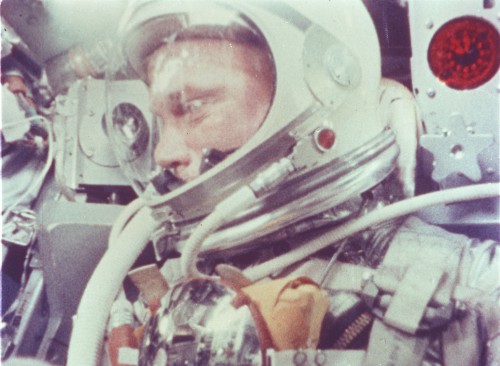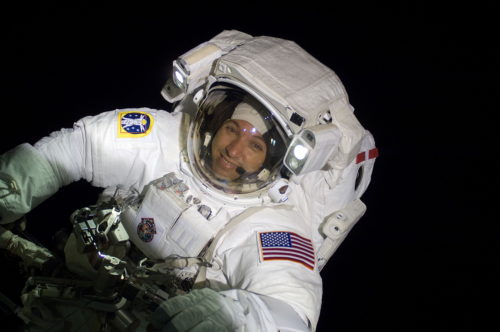
You might be forgiven for wondering why the Marine Corps Hymn was piped into the cabin of the Soyuz MS-05 spacecraft on the launch pad at Baikonur as darkness fell on 28 July. Over the years, it has not been unusual for astronauts and cosmonauts, about to head into space from this desolate expanse of Kazakh steppe, to listen to their choice of music in the final moments of countdown. But on this occasion, the Hymn heralded something different, for Soyuz MS-05 crewman Randy “Komrade” Bresnik would become not only the first Marine to serve a long-duration increment aboard the International Space Station (ISS), but also the first branch member to command the sprawling orbital laboratory.
Earlier today (Friday, 1 September), Bresnik assumed command of the station, taking over from Expedition 52 Commander Fyodor Yurchikhin, who has led the ISS since early June. The Marine Corps Colonel, who turns 50 later this month, will command Expedition 53 until mid-December.
[https://www.youtube.com/watch?v=5aYYOQPSt7U&feature=youtu.be&fref=gc&dti=584188521636085]
The Marines, of course, have a long heritage of involvement and achievement in U.S. human spaceflight. When America’s first class of NASA astronauts—the “Original Seven”—were selected in April 1959, their number included three Navy aviators, three Air Force fighter pilots and one highly decorated Marine, John Glenn. To great surprise in some quarters, Glenn missed out on becoming the first American in space, but instead won the seat on the nation’s first Earth-orbital mission in February 1962.

Glenn’s fame ultimately conspired against him and he did not fly again during the Mercury, Gemini or Apollo eras, although after a 25-year career in politics he rode aboard Space Shuttle Discovery in the fall of 1998, aged 77. Even today, Glenn stands as the oldest human ever to have journeyed into space. By the time of his second mission, many other Marines had ventured beyond Earth’s “sensible” atmosphere, performing spacewalks, leading shuttle crews and commanding space stations. But for a tragic twist of fate, one astronaut might have been the first and only Marine to have walked on the Moon.
Selected as a NASA astronaut in May 2004, Bresnik first flew aboard shuttle Atlantis on STS-129 in November 2009. During the 11-day flight, he performed two spacewalks, totaling 11 hours and 50 minutes, to install and outfit external stowage platforms on the ISS. In so doing, he became the 16th active-duty Marine to fly aboard the shuttle and only the fourth member of the service—after Skylab astronauts Jack Lousma and Gerry Carr and ISS flyer Carlos Noriega—to perform a spacewalk.
Bresnik was named to his second space mission in May 2016, initially targeting a Soyuz launch in November 2017. However, as outlined previously by AmericaSpace, the crewing arrangement changed late last year and Bresnik was moved forward on the manifest, launching on 28 July. After a month aboard the orbiting outpost, under the leadership of Expedition 52 Commander Fyodor Yurchikhin, he will take command of the station through mid-December.
In doing so, Bresnik becomes the first Marine to lead an ISS expedition. Although 52 increments have preceded his, since Expedition 1 in the fall of 2000, all have been commanded by civilians, Air Force, Navy or Army officers. Including Bresnik’s command, a total of 26 ISS increments have been led by U.S. astronauts, with Russia having logged 24 and the European Space Agency (ESA), the Canadian Space Agency (CSA) and the Japan Aerospace Exploration Agency (JAXA) one apiece. Of the 25 previous U.S.-commanded expeditions, ten have been led by Navy officers, six by Army officers, three by Air Force officers and six by civilians.

That said, Bresnik is not the first commander of a space station to hail from the Marine Corps. That honor went to Gerry Carr, who led the final voyage to Skylab from November 1973 through February 1974, becoming one of only four U.S. astronauts to command a crew on his first space mission. In fact, the Marines have produced a proud heritage of pilots-in-command on space missions, with Bob Overmyer piloting the first “operational” shuttle flight in November 1982, future NASA Administrator Charlie Bolden becoming the first African-American member of the Corps to fly into orbit and Bob Cabana and Rick Sturckow helming Endeavour’s STS-88 mission to deliver the initial ISS hardware into space.
All told, 19 active-duty Marine Corps aviators have traveled into space since February 1962, commanding no less than 16 shuttle missions. Jack Lousma led the third shuttle mission in March 1982, which saw Columbia alight—though not without drama—for the first and only time at White Sands, N.M. Bryan O’Connor led the first dedicated Spacelab life sciences mission, whilst Charlie Bolden commanded the first U.S. spaceflight to include a Russian cosmonaut. Ken Cameron guided Atlantis to its second docking with Russia’s Mir space station, whilst Rick Sturckow stands as one of only a handful of individuals who have journeyed to the ISS as many as four times.
In the last two decades, Marines have participated actively in the astonishing engineering accomplishment which today whirls around the globe every 90 minutes. Terry Wilcutt commanded the STS-106 crew in September 2000, which configured the station for its first long-term crew, whilst George Zamka helped deliver both the Harmony and Tranquility nodes and Douglas Hurley piloted the very last flight of the 30-year shuttle program. And it may just be Hurley who leads the inaugural Commercial Crew vehicle into low-Earth orbit, sometime in 2018, to return the United States to space, aboard a U.S.-built spacecraft, and from U.S. soil, for the first time since the end of the shuttle era.
Be sure to “LIKE” AmericaSpace on Facebook and follow us on Instagram & Twitter!






I last see the toilet ,mind your steps.